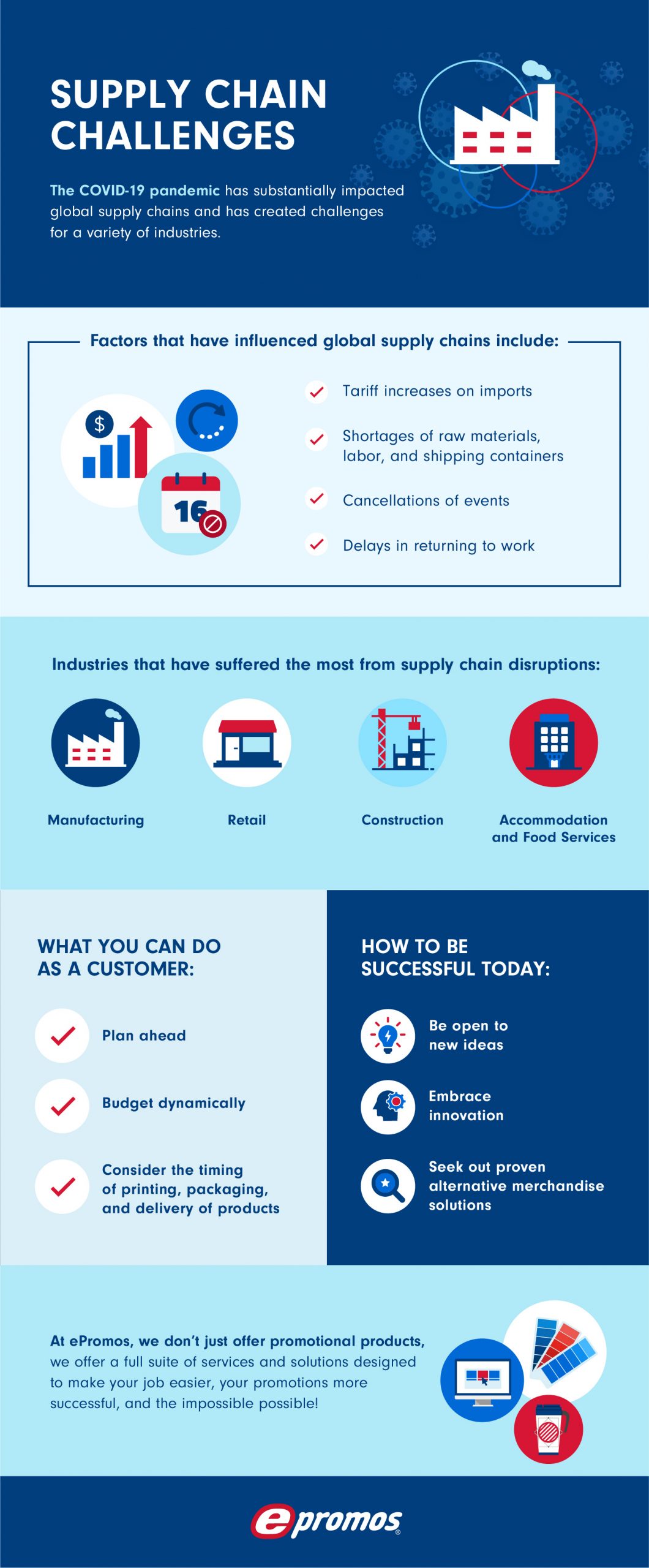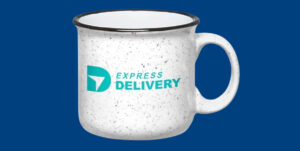09/20/2021
Supply Chain Challenges and the Promotional Product Industry
Recent events have changed the way companies understand supply chain management. COVID-19 continues to disrupt supply chains around the world, and other large-scale risks are always possible. As a result, preparedness is becoming the top priority for supply chain and marketing managers. Fortunately, you can take several precautions before disruptions occur.
How Does a Supply Chain Typically Operate?
A supply chain is a system that moves products from their original source to their final destination — the end-user. Today’s supply chains are complex and multifaceted. A supply chain often includes the following steps:
- Extracting the raw materials for a product
- Refining or manufacturing the product
- Assembling the materials into a product
- Selling the finished product
Ultimately, supply chain management is an essential part of business planning. It can result in decreased costs and faster product deliveries while helping companies avoid recalls and lawsuits, which are expensive, time-consuming and reputation damaging. Proper supply chain planning includes careful coordination of the following:
- Raw material sourcing
- The manufacturing process
- Product delivery
- Product returns

3 Supply Chain Challenges During COVID-19
COVID-19 and the unprecedented series of events it caused has led to various supply chain challenges. The global virus has affected every aspect of supply chains, from sourcing raw goods to keeping products on shelves. The most prevalent challenges have shifted throughout the pandemic, and it will take time to achieve a new status quo. Here are some of the most substantial supply chain issues resulting from COVID-19:
1. Greater Demand Than Supply
One of the biggest supply chain challenges has been an unusual demand influx. Since in-person shopping complicates social distancing efforts, many consumers have opted for online shopping throughout the pandemic. COVID-19 caused online orders to skyrocket, though the trend is on the decline. In addition to the influx of online shopping, the demand for specific products — like toilet paper, canned goods, and hand sanitizer just flew off the charts. Certain raw and refined materials have been the subject of shortages. Since the rollout of vaccines, a few shortages have limited dose availability. Large plastic bags, plastic filters, plastic pipes and the particles used to create cell cultures have been low in supply. The demand for vaccines has been greater than supply chains can manage. With such unpredictably high demand, many companies have found themselves with strained inventory and input shortages. Lacking inventory has been a major supply chain challenge during COVID-19. While most supply chains can withstand some variation in demand, the demand jumps were much greater than anyone had anticipated.
2. Increased Border Control
Most modern supply chains span across international borders. The United States Customs and Border Protection (CBP) agency and the Department of Homeland Security (DHS) have been working to secure borders against the spread of COVID-19. Other countries have also made their border security stricter to limit the virus’s spread. As a result, supply chain managers must deal with updated legal standards for importing goods across national borders. In many cases, said legal standards have led to delayed or obstructed shipments of raw materials or goods. While domestic supply chains have generally avoided legal barriers, it’s been a major obstacle for many companies.
3. Labor Shortages
Another pandemic-related supply chain challenge has been a massive labor shortage. In many industries, workers are reluctant to resume their pre-COVID positions due to safety worries or raised expectations. Countless companies have been raising wages, improving benefits or making other changes to attract workers. However, many of those who are not employed still hesitate to seek work. Some cite COVID-19 fears as their reason for not working, while others have care responsibilities at home. Almost half of those looking for a job are doing so passively, not urgently. Meanwhile, supply chains need labor to operate, as labor shortages complicate good production and shipment.
5 Common Supply Chain Risks
One of the most critical aspects of supply chain management is preparation. It’s vital to be prepared for as many situations as possible — supply chains face numerous potential risks, which could occur at a moment’s notice. Here are the five biggest supply chain challenges and how to overcome them.
1. Natural Disasters and Global Catastrophes
Significant catastrophes and natural disasters are risks you must consider — a tropical storm can blow away ocean carriers, a volcanic eruption can destroy a product warehouse and a new virus can wreak havoc on the entire world. Extreme weather events and natural disasters happen every year to some extent, meaning the supply chain is always at risk. Catastrophes also include human-made disasters, such as oil spills, which can limit trade routes or ruin shipments. These incidents might also be economic in nature, such as a stock market crash. While it may not be possible to plan for a specific disaster, following best practices with your supply chain management can help you be prepared.
2. Large Demand Fluctuations
Unpredicted demand fluctuations are often the result of a disaster or catastrophe — consumers “panic-buy” many of the same goods at the same time. In the early stages of COVID-19, consumers cleared the shelves of various home-good essentials. Such events make demand planning a fundamental part of supply chain management. The key to overcoming volatile consumer demand is resilience with demand fluctuations facing your supply chain.
3. Changing Political Landscapes
Another issue to consider is the instability of political landscapes. These risks include civil unrest and new or expiring policies. As a result, you might find your supply chain disrupted by steep new tariffs or trade restrictions. Alternatively, you might have to deal with the expiration of a trade invective program you’ve relied on. It’s important to anticipate political shifts — especially if part of your supply chain sits in an unstable region. Global political leaders might also pass legislation to minimize ecological impact and support sustainability. It’s essential to recognize how such laws could impact your supply chain. The best thing you can do is get ahead of the curve and work with ecologically conscious supply chain partners.
4. Economic Instability
Another threat to production lines is economic instability. It can lead to bankruptcies and closures along your supply chain. In many cases, economic instability is a by-product of natural disasters, human-made catastrophes, or political unrest. With the globalization of trade, one nation’s economic troubles could make their way into your supply chain. Being prepared for other disruptions can help you minimize the impacts of economic instability. Keep your ear to the ground, paying attention to international politics and weather predictions.
5. Cyber Attacks
Modern supply chains rely on technology, and cybersecurity breaches can disrupt entire trade networks. While some cyber attacks cause little more than a small ripple, others can be more damaging than real-world catastrophes. An attacker might copy or destroy sensitive or vital data — anywhere at any time. The internet is a necessity for today’s business processes, but connecting across global networks increases a supply chain’s risk. Though you may have mitigated your company’s internal cyber risks, it’s just as important to vet the members of your supply chain for their own cybersecurity precautions. Be sure to conduct regular audits, encrypt data before it reaches a supplier and keep careful track of which suppliers have access to what data.
How to Overcome Common Supply Chain Challenges
Some supply chain risks are less predictable and preventable than others. Even still, certain measures can help you be as prepared as possible for disaster. Here are five actions lead-time operations executives and supply chain managers can take now to prepare for a supply chain disruption.
1. Map Your Supply Chain
Before you can make evaluations or adjustments, you’ll need to know every detail about your supply chain. Who are your suppliers? Who are your suppliers’ suppliers? What does each supplier provide you? Where is each supplier located? The first step towards mitigating supply chain risks is to learn as much as possible about its members. Schedule meetings with colleagues from different areas of your organization. Collaborate to map out every single one of your suppliers, including those who only provide a few small items. Use a tool as basic as a spreadsheet or as complex as a designated supply chain software. Describe each supplier and how they connect to the others. Once you’ve created a supply chain map, keep it updated, adding new partners and deleting old ones. A well-mapped supply chain will also earn you points with consumers, who value transparency. For example, you might publish information about your suppliers or integrate a tool allowing consumers to track their packages. If you’ve taken steps to work with environmentally or socially conscious suppliers, you’ll be able to build a better reputation by sharing details about your supply chain map.
2. Evaluate Risks
There are several strategies to evaluate possible supply chain risks, such as a weighted ranking system. A weighted system involves assigning importance to various risk factors, including natural disasters or political unrest. Give each risk a weighted measure of importance. Then, score suppliers for the likelihood of each risk. The weighted average of those numbers will show you each supplier’s total risk as a figure. Compare suppliers’ total risk scores against one another. If your suppliers have high risk scores, you might consider finding new partners or adjusting your inventories. Quantifying different risk factors will help you understand the secureness of your supply chain to help you make decisions for operations planning.
3. Diversify Suppliers
One of the strongest methods for building resiliency is to diversify your suppliers. After creating your supply chain map, look for suppliers with adequate redundancy — those with multiple facilities spread across diverse regions. These partners will be best equipped to shift operations planning when needed. If your suppliers have poor redundancy, you might want to make a change or employ other strategies. It’s also essential to build relationships with multiple different suppliers. That way, one supplier’s crisis won’t blow a hole in your supply chain. Look for suppliers in different areas, as common risk factors can affect large regions at once. Keep a record of backup suppliers you can turn to when necessary.
4. Adjust Inventory Planning
The two basic inventory planning approaches are “just-in-time” or “just-in-case,” which vary in the following ways:
- “Just-in-time”: This approach puts emphasis on savings. It involves stocking only the materials or goods you expect to sell, with no more than a small buffer. While a “just-in-time” approach can reduce your purchasing and storage expenses, it can leave you vulnerable during a disaster.
- “Just-in-case”: “Just-in-case” is the opposite approach. It involves keeping larger inventories in case demand fluctuates or supply chain issues occur. Though you’ll be ready for disasters, you’ll also accumulate waste and spend more money on inventory.
If you have a high-risk supplier or little room for diversification, you might want to increase your inventories for relevant items. For example, you may have an item you can only source from a specific region, where natural disasters tend to strike at a certain time of year. Ultimately, the best solution is a mix of the two tactics. This way, you can enjoy the financial perks of a “just-in-time” approach, while also using other strategies — supply chain mapping, risk evaluation and supplier diversification.
5. Connect with Suppliers
Every member of your supply chain is a business partner. Each one plays a role in your success. Be sure to build relationships with your suppliers, scheduling regular calls and make an effort to be a good customer. Show your suppliers you value them as partners. As a result, your suppliers will be more likely to alert you of any impending issues, so you have time to prepare.
What to Expect Moving Forward
COVID-19 served as an eye-opener, showing supply chain managers where changes need to occur. Moving forward, expect the following shifts when it comes to supply chain management:
- Stronger risk prediction and management
- Streamlined and simplified supply chains
- More emphasis on supplier relationships
- Increased transparency
- Greater emphasis on climate awareness and action
Staying on top of supply chain trends will make you more competitive. Be sure to take steps to prepare for possible supply chain risks.
Learn How ePromos Can Help Your Business Shine
The unpredictable nature of risk — no matter its cause — makes precaution a fundamental part of supply chain management. Choosing the best supply partners is one of the ways you can minimize risk. If you need promotional products, consider working with ePromos. At ePromos, we provide a wide range of promotional products, such as bags, tech gadgets, drinkware and apparel. Thanks to our 110% satisfaction guarantee, shopping with us is risk-free. Check out our frequently asked questions page to learn more. If you’re looking to elevate your brand, browse ePromos products today.






